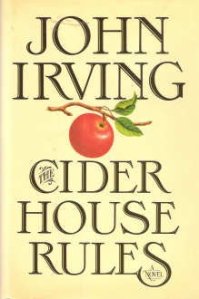 Title: The Cider House Rules
Title: The Cider House Rules
Author: John Irving
Year: 1985
Publisher: William Morrow
Date Read: March 5, 2013
Goodreads Rating: ~ 8.0 / 10
My Rating: 9.0 / 10
The Cider House Rules, John Irving’s (1942 – ) sixth novel is riddled with intricacies that make an already rich narrative all the more compelling. Initially centered around the adolescent development of Homer Wells, an orphan at Saint Cloud’s, and the orphanage’s director Wilbur Larch, the novel gradually expands to encompass a broader setting consisting of several areas in Maine as well as a growing set of perspectives and storylines. This expansion is masterfully done by Irving. The chapters slowly grow in length (beginning at around 35 pages and getting a little longer with each addition), and the spectrum of what each chapter takes in goes from isolation to being grand, yet interlaced.
The novel focuses thematically on the dilemma of deciding whether or not withholding information or lying is beneficial for others. This idea is at the forefront of the characters’ and reader’s conscience throughout the majority of the book, and, as a reader, I had as much difficulty as the characters did on choosing whether or not they should reveal their secrets. The Cider House Rules also deals with the ideas of abandonment and self worth, aptly labeled by Irving’s characters as being “of use.”
The characters themselves are brilliantly crafted by Irving. He shift perspectives more as the narrator’s omniscience grows and seamlessly switches between them without a moment’s notice. Despite the shifts being rapid, the new perspective thematically matches that of each previous one so that each transition is incredibly smooth. The characters each have unique attitude, and all of them stay true to form for the entirety of the novel.
Irving plays with language at different parts of the novel which causes the reader to make connections between different occurrences. Sometimes these instances are overt, yet at other times the association occurs almost unconsciously for the reader. One example that particularly struck me involved the character Homer Wells identifying himself as a Bedouin while Dr. Larch decides that Wells’ imagined persona attended Bowdoin College. The corollary between Bedouin and Bowdoin may not have been intentional on Irving’s part, although I am under the strong impression that it is, the similarity in the sounds of the self implied description of Bedouin and the college Bowdoin creates an echo and brings the idea that Homer is without a permanent home (the essential meaning the book uses for Bedouin) to the forefront of the reader’s mind.
The scenarios that play out in Irving’s novel are stretched to the point of almost (significant emphasis on almost) being completely unbelievable. Characters are seemingly fated to be reunited for different purposes and to destined to fulfill certain roles. That being said, though, the novel is one of few I’ve read recently where the plot is laid out as soon as the reader understands what the conflict is. Irving does an excellent job of keeping every reveal a surprise and hiding the direction that the novel is going until the twilight of the book, keeping the reader fully attentive to the plot and the intricate web that the characters find themselves in.
“That’s when he learned how to make the make-believe matter to him more than real life mattered to him; that’s when he learned how to paint a picture that was not real and never would be real, but in order to be believed at all – even on a sunny Indian summer day – it had to be better made and seem more real than real; it had to sound at least probable.”
Buy or see this book on Amazon
The Cider House Rules also became a film. Screenplay by John Irving.
I’ve always wanted to read this novel (currently reading Animal Farm by Orwell). You’ve written a great review!
Orwell is one of my favorite authors! Always happy to see another enthusiast of his work. This book is definitely worth getting your hands on.
I started reading this over Christmas but got sidetracked. I wonder if you’ve read The World According to Garp (also by Irving) because that is one of my favorites.
The World According to Garp, Widow for One Year, and A Prayer for Owen Meany are all books by him I really want to read soon.